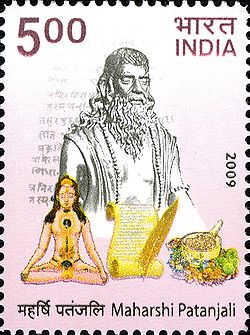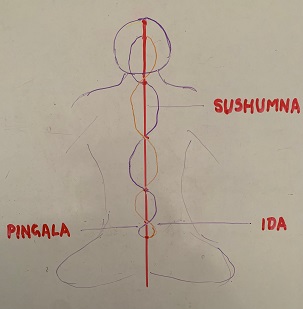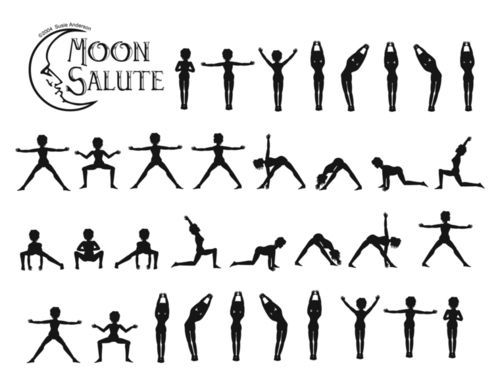Patanjali
Yoga Mantra
(Invocation
to Patanjali at the start of a Yoga Class)
योगेन
चित्तस्य पदेन वाचां ।
मलं शरीरस्य च वैद्यकेन ॥
Yogena
chittasya padena vacham | Malam
sharirasya cha vaidyakena ||
योऽपाकरोत्तमं
प्रवरं मुनीनां ।
पतञ्जलिं प्राञ्जलिरानतोऽस्मि ॥ Yopakarottam
pravaram muninam | Patanjalim
pranjaliranato’smi ||
आबहु
पुरुषाकारं ।
शङ्खचक्रासि धारिणं ॥
Abhahu
purushakaram Sankha
chakrasi dharinam |
सहस्र
शीरसं श्वेतं ।
प्रनमामि पतञ्जलिम् ॥
Sahasra
shirasam shvetam Pranamami
Patanjalim ||
ॐ
शान्तिः शान्तिः शान्तिः ॐ॥
Om
Shanti Shanti Shanti || |
 |
Meaning
of Patanjali Mantra
I
salute to the sage, Patanjali, who gave us yoga (yogena) for purifying
the mind
(chitta) words (pada) & speech (vacha).
To
remove the impurities (malam) of the body (sharirasya), patanjali gave
us the
medicine (vaidyakena).
Allow
me to go near to the one who has given these things to us.
To
Patanjali, I bow down my head with folded hands. Whose upper body has a
human
form (purushakaram), whose arms hold a conch (shanka chakrasi), a disc
and a
sword. The one who is crowned by a radiant white (svetam) thousand
headed
(sahasra shirasam) cobra. My salutations (pranamami) or pranam to the
incarnation of Adishesha (snake god).
More
on Patanjali Mantra
Learning
of any kind cannot happen unless you have the humility to learn, hence
when we
chant the invocation mantra at the beginning of the practice
visualizing the
lord (Patanjali in this case), we acknowledge that we are very small in
front
of the greatest soul. Once that is understood, the other afflictions,
mainly
the ego starts to get affected and we realize that we are coming down
to learn
something. This helps to surrender oneself to the practice and the
process of
sanctification begins from inside & true learning begins.
Below are
important yoga relevant terms for brief touch up to our practioners
reference reading.
Sadhana & Samadhi Pada:
Uttarayan:
(South to North Movement of Sun) is best period to start Yogic activity
since Best energy (coming from Sun) time. Hence Many does practice
Surya Namaskar during this time and those who cant they fly kites on
Makar Sankranti. The Sun enter into Makar Rashi(Zodiac). This is the
period (pada) of Samadhi. This time is most important for balanced
yogis to make effort towards stable spiritual attainment.
Dakshinayan: (North
to South Movement of Sun) is best period to do Sadhana. Yogic practices
for begginers can be practiced during this time where Sun move from
Karka to Makar Rashi(Zodiac).
The 4 paths of Yoga:
Yoga
manifests itself as four major paths, namely Karma Yoga, Bhakti Yoga,
Rāja Yoga and J˝āna Yoga. These four paths are like the branches of a
tree or tributaries of a river. They all have the same source and
resting place. In essence, they are all the same. Yoga works on the
level of one's body, mind, emotion and energy.
Karma
Yoga – the yoga of action and selfless service (Body). Bhakti Yoga –
the yoga of devotion(Emotions).
Rāja Yoga – the yoga of
meditation(Energy). J˝āna Yoga – the yoga of will and intellect(Mind).
When we meditate and perform yoga practices, we are Raja Yogis.
The
restlessness of the mind (Vikshepa) has caused our attention to become
carried away in stories and disconnected from our True Essence,
according to this path. The solution, then, is to calm the mind through
meditation in order to reveal the Oneness that we are in our truest
essence. This is done via the Ashtanga (8 limbs) system, as outlined by
Pata˝jali in the Raja Yoga Sutras.
Ashtanga:
यमनियमासनप्राणायामप्रत्याहारधारणाध्यानसमाधयोऽष्टावङ्गानि
The name “8 Limbs” comes from the Sanskrit term Ashtanga.
Ashtanga refers to the 8-limbed paths described by Patanjali in the
Yoga Sutras. “Astha” is the number eight and “ang” means limb. These 8
limbs of yoga, basically act as guidelines on how to live a meaningful
and purposeful life. They serve as a prescription for moral and ethical
conduct and self-discipline; they direct attention toward one’s health;
and they help us to acknowledge the spiritual aspects of our nature.
The
eight limbs of Ashtanga yoga outline ways to live a purposeful life.
The earlier limbs focus primarily on basic ethical teachings, and the
later limbs—including pratyahara, the fifth limb of yoga—focus on
internal concepts like meditation. The eight limbs of yoga are: |
Eight
limbs
of yoga. (Ashtang yog).
- Yama.
(Ahinsa, Satya, Asteya, Bramhacharya, Aparigrah)
- Niyama
(Shouch, Santosh, Tapa, Swadhyay, Ishwarpranidhan)
- Asana
(Annamaya Kosha)
- Pranayama (Pranamaya Kosha)
- Pratyahara
- Dharana
- Dhyana
- Samadhi
1-4
together called
Bahirang Yog, (External)
6-8
together called Antarang Yog.
(Internal)
5th limb is bridge between Bahirang
and Antarang Yog.
|
1.
Yama: Social restraints and moral codes of yoga. The Yoga Sutra
describes five different yamas, including ashimsa (non-violence),
asteya (non-stealing), satya (truthfulness), aparigraha
(non-possessiveness), and brahmacharya (celibacy or fidelity).
अहिंसासत्यास्तेयब्रह्मचर्यापरिग्रहा यमाः
2.
Niyama: Observances, rules, and guidelines. The Yoga Sutra describes
five different niyamas, including saucha (cleanliness), santosha
(contentment), tapas (self-discipline), svadhyaya (self-reflection),
and ishvarapranidhana (surrender to a higher power).
शौचसंतोषतपःस्वाध्यायेश्वरप्रणिधानानि
नियमाः
3. Asana: Yoga
postures. This limb emphasizes the importance of caring for
the body and developing the discipline to advance spiritual growth.
4.
Pranayama: Use of breath. Pranayama consists of breathing techniques
that can reduce stress and improve physical and mental health. In
pranayama, you focus deeply on breath control through inhalation,
breath retention, and exhalation patterns.
5. Pratyahara:
Withdrawal. Pratyahara involves disengaging your mind from external
disturbances and controlling your reaction to them. During pratyahara,
your five sense organs still detect external stimulation, but you don't
allow them to disrupt your state of mind.
6. Dharana: Concentration.
The goal of dharana is to bind your consciousness to one particular
object, place, or idea. Focusing your attention on one thing helps
quiet your mind by closing off paths by which other thoughts intrude.
7.
Dhyana: Meditation. Dhyana is similar to dharana, except during dhyana,
you reach a state of being where you are so completely immersed in your
meditation that it becomes a part of your consciousness.
8. Samadhi:
Bliss or enlightenment. Samadhi is the highest state of consciousness
you can achieve through meditation. It consists of a yoga practitioner
reaching spiritual enlightenment where the self, the mind, and the
object of meditation merge together into one.
Every limb builds
off of techniques in the previous limb. As such, the conscious
withdrawal of energy from the senses during pratyahara is an important
preparatory measure before you dive into the more internal,
meditation-based later steps of dharana, dhyana, and samadhi.
Shatkarma:
The
Shatkarmas (Sanskrit: षटकर्म ṣaṭkarma literally six actions), also
known as Shatkriyas, are a set of Hatha yoga purifications of the body,
to prepare for the main work of yoga towards moksha (liberation).
Practicing shatkarmas internally purifies the body, which makes
pranayama and meditation practice easier by preparing the body to
perform these practices without distraction, discomfort or fatigue.
The shatkarmas should always be learned from and practiced under the
supervision of an experienced teacher.
Yogic Cleansing - (Shatkarma) 1. Neti (Jal), 2. Dhauti
(Waman), 3. Nauli, 4. Basti, 5. Tratak, 6. Kapalbhati
Pranayam:
Those
who follow yoga may have heard of the practice of pranayam. The word is
derived from 'Prana' which stands for 'life force' and 'Ayama' which
means 'to lengthen or to work on it'.
Meaning
of Pranayam:
Tasmin
sati shwas prashwasyogartivichhedah: pranayama
Transalation:
during breathing motion those make difference in speed and holding the
breath
(pran) called Pranayam.
Main Types of Pranayam:
1. Suryabhedan, 2. Ujjayi, 3. Sitkari,
4. Sheetali, 5. Bhastrika, 6. Bhramari, 7. Murchha, 8. Plawini
Pranayam
practice has to be praticed under guidence or after understanding the
correct method. one has to understand own body and adjust accordingly
to stat with low intesity.
Ida, Pingala,
Shushumna, Chakras:
As per yoga texts, the life force energy (otherwise known as "prana")
travels
through the subtle body in a series of channels, called "nadis". There
are 72000 nadis as per yogic text and
are immportant one. They are sushumna, ida, pingala, gandhari,
hastajihva, yashasvini, pusha,
alambusha, kuhu, and shankhini. Among these 10 the most importants
depicted in many texts are sushumna,
ida, pingala. These nadis intersect at points of intensified energy,
called "chakras".
The chanting of these Chakra Beeja Mantras activates the center of the
body, bringing balance in these chakras. The balanced chakras ensure
the body is healthy, fit, and active.
| Seven Chakras -
Beej Mantra- Color - Relative Asana |
Chakras top to bottom |
Muladhara
(Root) Chakra - LAM (Red) - Tadasan/Pranamasan
Swadhisthana (Sacral) Chakra - VAM (Orange) -
Virbhadrasan II
Manipura (Solar Plexus) Chakra - RAM (Yellow) -
Kumbhakasan
Anahata (Heart) Chakra - YAM (Green) -
Ustrasan
Vishuddha (Throat) Chakra - HAM (Blue) - Setu Badha
Sarvangasan
Ajna (Third Eye) Chakra - AUM (Violet) -
Vrkshasan
Sahasrara (Crown) Chakra - AH
(White) - Shavasan |
 |
| Root |
Sacral
|
Solar
plexus |
Heart |
Throat |
Third
eye |
Crown |
Vajrasanc
Utkatasan
Dandasan
Malasan
Samasthiti
Virbhadrasan
Setubandhasana |
Goddesspose
Bhadrasan
Trikonasan
Ashwasanchalanasan
Paschimottanasan
Supta Vajrasan |
Kumbhakasan/planks
Adhomukhshwanasan
Naukasan
ParivrttaTrikonasan
PawanMuktasan
Dhanurasan
Ashwasanchalanasan |
Uttanasan
Matsyendrasan
Natarajasan
Ushtrasan
Chakrasana
Bhujangasan
Dhanurasan |
Sarvangasan
Halasan
Sinhasan
Marjarasan
Matsyasan |
Vajrasan
Adhomukhshwanasan
JanuShirishasan
Padmasan
Garudasan
Shashankasan |
Vrkshasan
Uttanasan
Shirishasan
Vrshikasan
Padmasanaa |
| Mudra |
|
|
|
|
|
|
| Ganesh |
Yoni |
Kali |
Padma |
Gyan |
Hakini |
Crownc |
| Surya Namaskar Starting Mantra |
Meaning |
|
॥
ध्येयः सदा सवित्र मंडल मध्यवर्ती नारायण सरसिजा सनसन्नि विष्टः
केयूरवान मकरकुंडलवान किरीटी हारी हिरण्मय वपुर धृतशंख चक्रः ॥
DHYEYAH
SADA SAVITRI MANDALA MADHYAVARTI NARAYANAH SARSIJA SANA SANNI VISHTHAH !
KEYURVAN MAKAR KUNDALA VAAN KIRITI, HARI HIRANYA MAYA VAPUR DHRIT
SHANKHA CHAKRAH ||
|
One
should meditate on the form of Lord Narayana situated in the orb of the
Sun. He is seated on a Lotus, with golden bracelets, crown, shark
earrings; He has golden complexion, and holds the Shankha and Chakra in
his hands. |
Surya Namaskar Yoga Mantra, Meaning & Bijakshar Mantra:
There
are certain chakras corresponding
to each asana. Attention is being brought to them when performing Surya
Namaskara. It’s recommended to synchronize postures, breath, mantras
and bring attention to certain chakras when performing Surya Namaskara.
It needs complete devotion. It is suggested
to give Surya Namaskara an urgent place in your daily routine. And like
the daily rising of the sun. Surya Namaskara is indeed a daily routine.
| Mantra |
Meaning
Salutations to
the one who: |
Bijakshar Mantra |
Om Mitraya Namah
Om Ravaye Namah
Om Suryaya Namah
Om Bhanave Namah
Om Khagaya Namah
Om Pushne Namah
Om Hiranyagarbhaya Namah
Om Marichaye Namah
Om Adityaya Namah
Om Savitre Namah
Om Arkaya Namah
Om Bhaskaraya Namah
Om Shree Savitra Surya Narayanay Namah
|
is friendly
(Mitraya) to all
shining or radiant (Ravaye) one
dispels darkness (Surya meaning light)
illuminates (Bhanave)
is all pervading (Khagaya)
provides nourishment (Pushne) in the form of energy
shines in a golden colour (Hiranyagarbhaya)
gives light with infinite rays (Marichaye)
is the son of Aditi (Adityaya), the divine cosmic mother
is responsible for life (Savitre)
is worthy of praise and glory (Arkaya)
responsible for the cosmic illumination (Bhaskaraya).
<--------------------ॐ-------------------->
|
Om Hram Mitraya Namah
Om Hrim Ravaye Namah
Om Hroom Suryaya Namah
Om Hraim Bhanave Namah
Om Hraum Khagaya Namah
Om Hrah Pushne Namah
Om Hram Hiranyagarbhaya Namah
Om Hrim Marichaye Namah
Om Hroom Adityaya Namah
Om Hraim Savitre Namah
Om Hraum Arkaya Namah
Om Hrah Bhaskaraya Namah
Om Shree Savitra Surya Narayanay Namah |
| Surya Namaskar Ending Mantra |
Meaning |
॥
आदित्यस्य नमस्कारान् ये कुर्वन्ति दिने दिने
आयुः प्रज्ञा बलं वीर्यम् तेजस्तेशान् च जायते ॥
ADITYASYA NAMASKARAM YE
KURVANTI DINE DINE
AAYUH PRADNYA BALAM VIRYAM TEJASTESHANCH JAYATE||
|
Those who performs
Suryanamaskara daily is untouched by poverty for his
thousand lifetimes. O Lord Sun , Salutation to you . Please protect me
from all ill effects that fate may have in store for me |
| | | Surya Mantra | Surya Namaskar Mantra / सुर्य नमस्कर मन्त्र, | Surya Mantra: Om Hranm Hrinm
Hronm Sah Suryay Namah
सूर्य
मंत्र: ऊँ ह्रां ह्रीं ह्रौं सः सूर्याय नमः।
Beej Mantra: Ram.
Color: Yellow
Related deity: Lord Sun
Related Planet: Surya (Sun) | Om hiraṇmayena pātreṇa satyasyāpihitaṁ mukham tat tvaṁ pūṣann apāvṛṇu satya-dharmāya dṛṣṭaye
ॐ हिरण्मयेन पात्रेण, सत्यस्यापिहितं मुखं,
तत्वं पूषन्नपावृणु, सत्य धर्माय दृष्टये,
Om Shaantih Shaantih Shaantih
ॐ शांतिः शांतिः शांतिः |
Note:
Information published here is for reference purpose only. We recommend
proper guidence should be
taken from the trained authority for
these practices.
The
purpose of these listing/detailing here is
for quick check. We have
collected these information from various internet sources for
selected
practictioners reference only.
|




